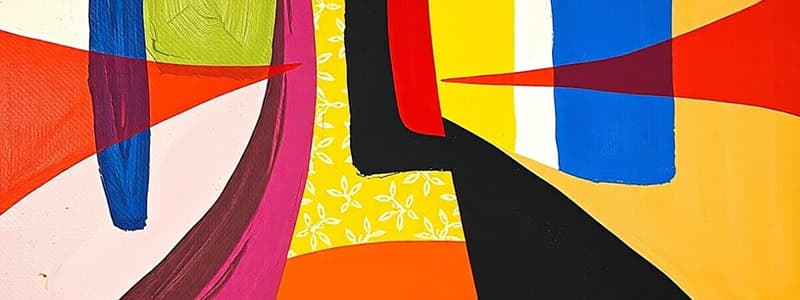Podcast
Questions and Answers
What are the primary forms of visual arts?
What are the primary forms of visual arts?
Painting, sculpture, drawing, photography, and printmaking.
List two elements that are crucial in performing arts.
List two elements that are crucial in performing arts.
Acting and choreography.
Name one technique commonly used in literature.
Name one technique commonly used in literature.
Character development.
What are two branches of music?
What are two branches of music?
Identify one principle of design.
Identify one principle of design.
How do creative arts contribute to cognitive development?
How do creative arts contribute to cognitive development?
What current trend is seen in the creative arts?
What current trend is seen in the creative arts?
How does integrating creative arts in education benefit students?
How does integrating creative arts in education benefit students?
What is one therapeutic benefit of creative arts?
What is one therapeutic benefit of creative arts?
Name one type of genre found in literature.
Name one type of genre found in literature.
Flashcards are hidden until you start studying
Study Notes
Overview of Creative Arts
- Creative arts encompass various forms of artistic expression.
- They include visual arts, performing arts, literature, music, and design.
Visual Arts
- Forms: Painting, sculpture, drawing, photography, and printmaking.
- Techniques: Use of color, composition, texture, and perspective.
- Mediums: Oil, acrylic, watercolor, clay, metal, and digital formats.
Performing Arts
- Types: Theater, dance, music, opera, and performance art.
- Elements: Acting, choreography, stagecraft, and audience engagement.
- Genres: Drama, comedy, tragedy, ballet, modern dance, and musical theater.
Literature
- Categories: Poetry, prose, drama, and non-fiction.
- Techniques: Narrative structure, character development, symbolism, and themes.
- Genres: Fiction, fantasy, horror, romance, and historical.
Music
- Branches: Classical, jazz, rock, pop, folk, and electronic.
- Elements: Melody, harmony, rhythm, dynamics, and timbre.
- Instruments: Strings, percussion, wind, and electronic instruments.
Design
- Areas: Graphic design, fashion design, interior design, and industrial design.
- Principles: Balance, contrast, emphasis, movement, pattern, rhythm, and unity.
- Tools: Software (Adobe Creative Suite), sketching, and model-making.
Importance of Creative Arts
- Expression: Provides a means for individuals to express emotions and ideas.
- Cultural Reflection: Reflects societal values, beliefs, and histories.
- Cognitive Development: Enhances critical thinking, problem-solving, and creativity.
- Therapeutic Benefits: Used in art therapy to promote mental well-being and healing.
Education and Creative Arts
- Integrating creative arts in education enhances learning experiences.
- Encourages teamwork, innovation, and self-discipline among students.
Current Trends
- Rise of digital and multimedia art forms.
- Increased collaboration between different artistic disciplines.
- Focus on sustainability and social issues in creative works.
Overview of Creative Arts
- Creative arts encompass diverse artistic expressions including visual arts, performing arts, literature, music, and design.
Visual Arts
- Forms include painting, sculpture, drawing, photography, and printmaking.
- Techniques such as color usage, composition, texture application, and perspective are essential.
- Mediums utilized are oil, acrylic, watercolor, clay, metal, and digital formats.
Performing Arts
- Types consist of theater, dance, music, opera, and performance art.
- Key elements include acting, choreography, stagecraft, and engaging the audience.
- Genres range from drama, comedy, and tragedy to ballet, modern dance, and musical theater.
Literature
- Categories comprise poetry, prose, drama, and non-fiction.
- Writing techniques involve narrative structure, character development, use of symbolism, and thematic exploration.
- Popular genres include fiction, fantasy, horror, romance, and historical narratives.
Music
- Branches of music feature classical, jazz, rock, pop, folk, and electronic genres.
- Essential elements include melody, harmony, rhythm, dynamics, and timbre.
- Common instruments include strings, percussion, winds, and electronic devices.
Design
- Areas of design include graphic design, fashion design, interior design, and industrial design.
- Core principles focus on balance, contrast, emphasis, movement, pattern, rhythm, and unity.
- Tools used range from software like Adobe Creative Suite to sketching and model-making techniques.
Importance of Creative Arts
- Provides a medium for emotional and idea expression.
- Reflects societal values, beliefs, and historical contexts.
- Enhances cognitive skills, including critical thinking, problem-solving, and creativity.
- Has therapeutic benefits, commonly utilized in art therapy to foster mental well-being and healing.
Education and Creative Arts
- Integration of creative arts in education enriches learning experiences.
- Cultivates skills such as teamwork, innovation, and self-discipline among students.
Current Trends
- Digital and multimedia art forms are gaining popularity.
- Collaboration across various artistic disciplines is on the rise.
- There is a growing focus on sustainability and social issues within creative works.
Studying That Suits You
Use AI to generate personalized quizzes and flashcards to suit your learning preferences.




